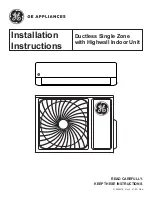
8
Use refrigerant certified to AHRI standards. Use of used
refrigerant may cause compressor damage that is not
covered under warranty. Most portable machines cannot
clean used refrigerant to meet AHRI standards.
CAUTION
NOTICE
Violation of EPA regulations may result in fines or other
penalties.
Operating the compressor with the suction valve closed
may cause serious compressor damage.
CAUTION
Final Charge Adjustment
The outdoor temperature must be 60°F or higher. Set the
room thermostat to COOL, fan switch to AUTO, and set the
temperature control well below room temperature.
After system has stabilized per startup instructions, check
subcooling and superheat as detailed in the following sec-
tion.
Expansion Valve System
1. Purge gauge lines. Connect service gauge manifold
tobase-valve service ports. Run system at least 10 min-
utes to allow pressure to stabilize.
2. Temporarily install thermometer on liquid (small) line
near liquid line service valve with adequate contact and
insulate for best possible reading.
3. Check subcooling and superheat. Systems with TXV ap-
plication should have a subcooling of 11 ± 2 ºF and su-
perheat of 9 ± 1 ºF.
a.
If subcooling and superheat are low,
adjust
TXV
to 9 ± 1 ºF superheat, then check subcooling.
NOTE:
To adjust superheat, turn the valve stem clock-
wise to increase and counter clockwise to de-
crease.
b.
If subcooling is low and superheat is high,
add
charge to raise subcooling to 11 ± 2ºF then check
superheat.
c.
If subcooling and superheat are high,
adjust
TXV
valve to 9 ± 1 ºF superheat, then check subcool-
ing.
d.
If subcooling is high and superheat is low,
adjust
TXV valve to 9 ± 1 ºF superheat and
remove
charge to lower the subcooling to 11 ± 2ºF.
NOTE:
Do
NOT
adjust the charge based on suction pres-
sure unless there is a gross undercharge.
4. Disconnect manifold set, installation is complete.
Subcooling Formula = Sat. Liquid Temp. - Liquid Line Temp.
NOTE
: Check the Schrader ports for leaks and tighten valve
cores if necessary. Install caps finger-tight.
System Charging Heating Mode.
Measure the hot gas dis-
charge at the compressor to check the system charge in heat
mode.
1. Allow the system to operate for at least 20 minutes.
2. Attach and insulate an electronic thermometer to the
hot gas discharge line mid way between the compres-
sor and the reversing valve.
Note:
The thermometer is
to be well insulated to prevent ambient influences.
3. Adjust the charge to maintain a clear sight glass.
4. Allow the compressor to operate for about 10 additional
minutes and measure the hot gas discharge tempera-
ture.
5. Using an additional electronic thermometer, measure
the ambient.
6. Adjust the charge until the hot gas temperature equals
105
º
F + ambient (+ or – 5
º
F). Remove charge to increase
the temperature.
NOTE:
When adjusting the charge, allow the compressor to
operate for about 10 minutes before taking readings.
NOTE:
Subsequent opening and replace of the cap will
require only 1/2 to 1 hex flat. See the table below for the
torque required for an effective seal on the valve bonnet (1/6
turn past finger tight.
TUBING SIZE
TORQUE
(ft-lbs)
5/8
14
1 3/8
16
After closing the valve bonnet, perform a final refrigerant leak
test on the valves and sweat connections. Return the room
thermostat to the desired settings.
Defrost Control Adjustments
The GSH uses a Time/Temperature method for defrost. A
thermal sensor electrically set to “Normally Open” is wired to
the electronic defrost control located in the control box. The
thermal sensor attached to the condenser coil determines
the outdoor coil temperature.
Both coil temperature and compressor “run time” determine
defrosting of the outdoor coil. Adjustments to the defrost tim-
ing selection can be changed from the 60 minute factory set-
ting to either 30 or 90 minutes by moving the jumper on the
defrost control. For the system to initiate a defrost, the fol-
lowing statements must be true:
•
The Defrost Sensor is closed, and
•
The compressor “run time” is equal to the timing selec-
tion on the defrost board.





































